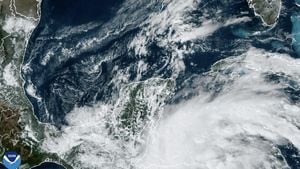The Philippines is currently grappling with extensive cleanup efforts following the devastation wrought by Typhoon Man-yi, which has left at least 36 people dead and resulted in significant damages. This typhoon marks the sixth major storm to impact the nation within the past month, raising serious concerns about the increasing frequency of severe weather events attributable to climate change.
Authorities are working tirelessly to restore order and safety across various affected regions, especially on the islands of Catanduanes, where the typhoon made landfall. Thousands have been evacuated as flash floods and landslides threaten to disrupt daily life. The Philippine Coast Guard has mobilized personnel who are seen clearing debris, including fallen trees from highways and conducting rescue operations.
During the height of Typhoon Man-yi, coastal communities experienced powerful winds exceeding 200 kilometers per hour, accompanied by torrential rains. Footage from local news outlets showcases the sheer force of the storm: waves crashing over sea walls, streets submerged, and roofs stripped from homes. This has prompted not only local helpers but volunteers from neighboring regions to join the recovery efforts.
Local government officials and community leaders are urging residents to remain vigilant, as weather forecasts indicate more rain is expected, complicateing the recovery process. During previous storms, some areas were already at risk from swelling rivers, leading to fears of imminent mudslides and more flooding, altering the geography and safety of their towns permanently.
Millions of pesos are being directed toward emergency response and restoration efforts, with significant international aid pledged. Volunteers from civic groups and non-profits are organizing relief drives to provide food, water, and other essentials to those displaced by the storm. Numerous organizations are setting up donation centers to collect supplies and monetary contributions to help facilitate the support.
Among the towns hardest hit, Panganiban and Virac had buildings extensively damaged. Graphic images reveal roofs ripped away and structures leaning precariously, leaving families homeless. Sought after help from government agencies and NGOs have sparked economic discussions about infrastructure resilience and disaster preparedness strategies.
While the cleanup is underway, locals are recovering from the emotional toll of such disasters. Many are recounting harrowing stories of how they survived, often aiding neighbors during the worst of the winds and rains. Among these tales, there’s solidarity; communities are pulling together with hope and determination.
Government officials are urging the national leadership to conduct assessments leading to more immediate relocations for those living along hazard-prone lines. They stress the need for improved evacuation protocols, emphasizing the need for resilience planning against future storms likely intensified by climate change.
Looking beyond immediate clean-up, the government is under pressure to evaluate the efficacy of predictive tools employed for storms, to improve early warning systems as such storms become the new normal. Climate scientists reiterate the importance of investing heavily not just on emergency responses, but also on comprehensive education about climate preparedness.
The emotional and economic recovery from Typhoon Man-yi will take time, leaving long-lasting marks across the impacted regions. Yet through the debris, there’s also hope. Even amid devastation, there lies potential: communities banding together, finding strength from unity, and the relentless human spirit to rebuild and learn.



